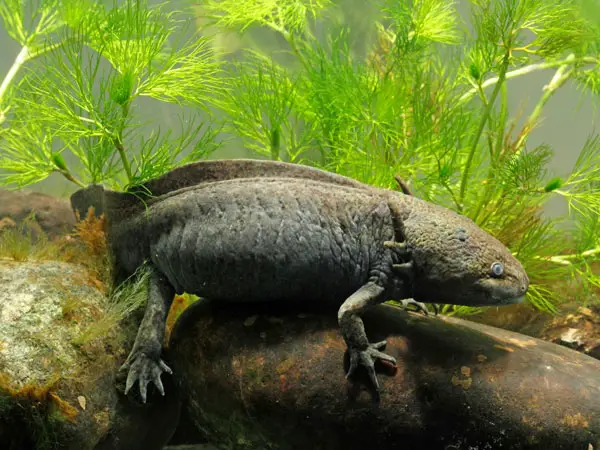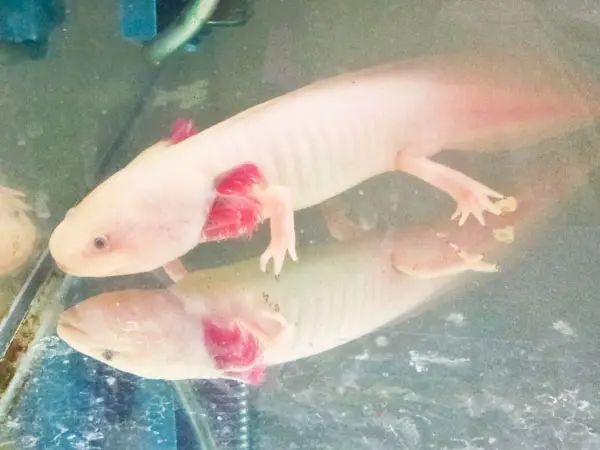
Yes, axolotls have teeth both in their upper and lower jaws. If you’re worried that your axie is going to bite you, don’t — axolotl teeth aren’t sharp enough to penetrate the skin or cause any serious injury.
If you’re considering hand-feeding your axolotl and you’re worried about getting bitten or getting hurt, I will explain why that fear is unfounded and why you shouldn’t worry.
That said, I don’t encourage you to actively try to get yourself bitten. Although it never happened to me, I did read about some keepers getting bitten by large wild axolotls that caused bleeding, but these are extremely rare occurrences and possibly a bit over-exaggerated accounts.
If it does happen that your axolotls will bite you during feeding time, you’ll see that it’s a bite that couldn’t tear your skin nor cause damage.
Do Axolotls Chew Their Food?
Axolotl teeth are not sharp, and you may not even be able to see their teeth because they’re small and don’t have any protruding edges.
This is one of the reasons why you don’t see axolotls chew or tear apart their food. What they do when feeding is suddenly open their mouths wide and suck in water and food.
In fact, the word Ambystoma in the Latin name of axolotls — Ambystoma mexicanum — means cup-mouth, which is a good visual when it comes to understanding how axolotls feed.
Their teeth are simply useful for gripping food. Because they don’t chew food, you’ll need to feed axolotls with food that is small enough to be swallowed whole.
You can chop larger food into smaller pieces to avoid getting it stuck somewhere in the axolotl’s gastrointestinal tract.
Food that is too large can cause indigestion, constipation, and impaction in more serious cases. It’s best to avoid putting this sort of strain on your axolotls, so make sure food is sized appropriately for them to swallow.
What Do Axolotls Eat?
Axolotls are carnivores that will eat a variety of meaty foods. In the wild, axolotls eat whatever it’s available for them in the swampy waters and canals of the lake complex Xochimilco.
Small crustaceans, small fish, frog tadpoles, insects, worms, mosquito larvae and other small meat-based foods are all part of an axolotl’s diet in the wild.
Axolotls raised in captivity must also be raised on a meat-based diet. Staples of captive raised axolotl diet include earthworms, black/white worms, live brine shrimp, live daphnia, sinking salmon pellets.
Earthworms must be chopped into smaller pieces before they’re fed to axolotls. Earthworms can have soil or dirt on them, so I recommend washing them thoroughly before feeding them to your axies.
Axolotls don’t require daily feedings, which makes them a low-maintenance pet in this respect. It’s enough to feed your axolotl every 2-3 days, because that’s how long it takes for them to digest food.
Overfeeding can cause constipation, trapped gas in the GI tract, and even more serious complications like bowel obstruction.
What to Do If you Get Bitten By An Axolotl?
If you’re planning on placing your hand into the aquarium, expect your axie to try to get a taste of your hand.
While the bite itself isn’t painful, you could get a scare from the ferociousness with which they attack you. Your reaction here may be to yank back your hand but try to resist doing that because there’s a change you may hurt your axolotl.
Some aquarists choose to feed their axolotls with long tweezers to avoid placing their hands into the aquarium. Others will hand-feed them, which does carry the risk of being bitten.
For an axie, your fingers probably look like some huge ‘noom-worthy’ worms, so it’s natural that they’ll try to get a taste.
Because they don’t have any dental power to actually cause more harm than an indentation on your skin, there’s not much to be worried about if you do get bitten.
If you don’t want to get bitten, don’t place your hand into the tank. It’s simple as that.
If, for whatever reason, you must place your hand into the tank and you do get bitten, as I explained above, don’t immediately yank away your hand as you may hurt your axolotl in the process.
Best is to let you axolotl figure out you’re not actually edible and they will release your finger on their own. In fact, after a couple of occasions of having snapped down on your finger, they’ll get used to you and probably won’t attempt to bite again.
If the bite does leave some mark on your finger or hand, or if the skin is broken, best if you use an antiseptic to clean the area of the bite as axolotls may carry salmonella, plus there’s also bacteria in the water.
Therefore, to sum up: If bitten by your axolotl, don’t try to shake it off your hand as you may end up hurting it. If there’s broken skin, be sensible and use an antiseptic to clean the area.
Axolotls are quick to snap down on prey, so don’t be surprised if you don’t see your axolotl’s attack coming. The key is to remain calm and they will release your finger or whatever part of your hand they tried to get a taste of.
Conclusion
The teeth of axolotls are small, rubbery and not designed for tearing away ore chewing prey. Instead they offer a bit of friction when food is ingested, and they help axolotls snap down on food easier. If small enough, food is ingested whole, so there’s no need for teeth anyway.
Axolotls are known to literally bite the hand that feeds them, but their bite is not strong enough to break the skin or cause bleeding.
Still, your axolotl may get you at an angle which can be a bit painful (e.g. between your fingers or other soft tissue of your arm) and the bite may leave a bit of indentation, but it’s unlikely to cause any serious harm. Even so, it’s best to be careful and disinfect any bite mark.




